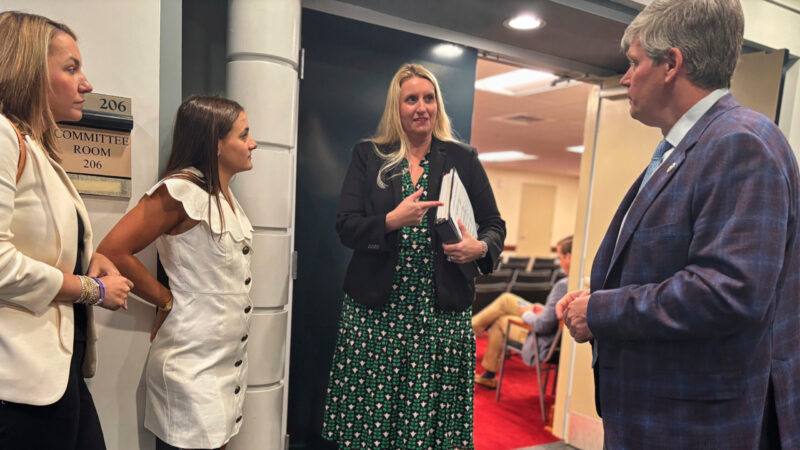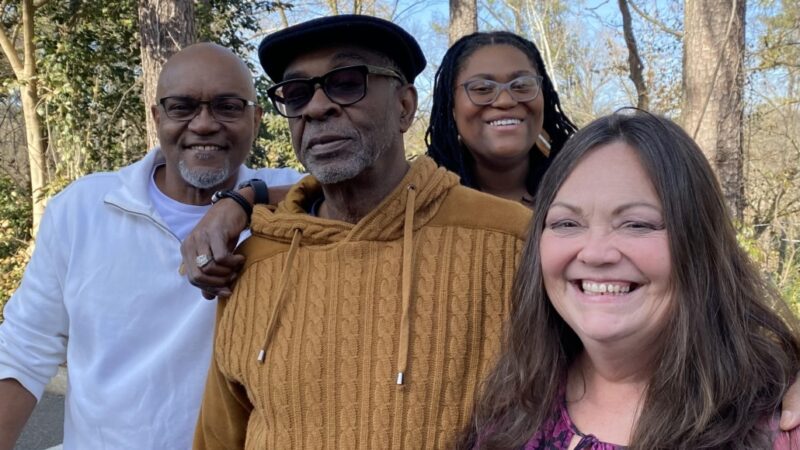After Helene’s floods, North Carolina tries to tame trauma’s lasting damage
ASHEVILLE, N.C. – Sebastian Saraellno Paez’s parents already were in a panic, he recalls, when he woke up on Friday, Sept. 27. Hurricane Helene hit the night before and now, water — two feet deep and rising — surrounded his family’s home.
Trying to remain calm and think about solutions, the 17-year-old high schooler poured himself a bowl of Cheerios. “Beginning at that point, my brain put itself into survival mode,” he says. “Where I’m not really processing anything emotionally.”

He and his family live in Swannanoa, North Carolina. It’s a working class town populated by the restaurant servers, hotel staff and house cleaners who keep nearby Asheville running. His parents immigrated here from Mexico years ago. Mobile home parks are built precariously into the town’s mountain coves, and many were inundated by Helene. Now piles of rubble and wood sit in place of houses.
More than 200 people died in Hurricane Helene — roughly half of them in North Carolina — and hundreds of thousands more were displaced. In North Carolina, 27 counties were designated under a major disaster declaration. Many of the homes destroyed were not insured. A recent report from the N.C. governor’s office estimated more than 70,000 homes in the state were damaged.
Collective trauma a slow-moving crisis
Today, while some families have reached a fragile equilibrium, mental health professionals warn there is a slow-moving crisis taking hold as a result of the collective trauma that people here endured. Practitioners caution that its effects will be felt for years, and that the quality and level of mental health care people receive in the coming months will be critical.
For Sebastian, the sense that he was watching a movie version of himself and his family persisted for the next 24 hours after the storm hit. He watched his family as they tried and failed to call 911 and as they eventually fled their home in waist-deep water for higher ground at a neighbor’s house. Finding it empty, they broke in through a window. That turned out to be a life-saving decision. They watched as their own house became almost fully submerged.

Perhaps his most salient memory, says Sebastian, is the moment he admitted to himself that they might not make it out alive. It was after they’d tried and failed to get into the attic of their neighbor’s house.
“I felt like I was standing at the gates almost,” he remembers. “Starting to come to a point where if the water kept rising higher, I might not see another day.” His mom, Maria Paez, sat next to him, chanting and praying. Water was rising all around him, creeping up the sides of the couch on which they sat.
Sebastian closed his eyes. Like taking a nap, he told himself. Think of happy memories.
“Just as I was doing that,” he says, “my dad notices — the water’s not going as strong as it was.”
Miraculously, the water receded. The family made it out alive.
Mental health needs will demand millions in investments
Trauma is sneaky and unpredictable. In a collective disaster such as Hurricane Helene, some researchers forecast 20-40% of a population will experience post-traumatic stress disorder, which can be debilitating and peak months or years after a traumatic event. Right now — as survivors are finally starting to take stock of the experience — is a critical time when people can either integrate their experiences and move through them, or get stuck trying to process them.
“It’s very hard for people to get better and to improve their mental health if they don’t have a safe place to live,” says Tracy Hayes, who oversees the state government entity tasked with providing mental health services post-Helene, Vaya Health. The state has pledged $25 million in mental health resources. Congress approved billions of additional dollars for hurricane recovery in December.

In the early days after the storm, the state hired crisis counselors and placed them in walk-in centers. Now, they’re working on fortifying their work force of mental health professionals to meet longer-term needs.
But delivering this kind of care to displaced families is a challenge. Hayes points out that on the hierarchy of needs, therapy comes after food and shelter — and in the absence of these basic needs being met, existing trauma can be exacerbated. “People are living in tents, or living with friends and family members,” says Hayes, “which we know can also impact mental health.”
The Paez family is staying with friends now, returning to their home every day to tear down water-damaged walls with a plan to rebuild. Their house is stripped to the studs. Local church groups and nonprofits have mobilized to help the family, including LEAF Global Arts. Before the storm, the organization’s executive director, Jennifer Pickering, was occupied with supporting local artists and curating festivals. Now she is working nearly full-time to help families impacted by the storm in Swannanoa, including the Paez family.
Standing in their stripped down house recently, Pickering hugs Maria Paez as Maria gently sobs. It’s one of the first times she’s cried since the storm, says Maria. “You’ve been so strong for everyone,” says Pickering.
“I have to for my kids,” replies Maria.
Traumatized trauma therapists
Even for the survivors who were not displaced by Helene, mental health recovery is slow going, and therapists here say the situation here has demanded they rethink how they deliver care or negotiate boundaries with their patients. “There’s a therapy session where somebody has, you know, signed up, come in, may or may not be using their insurance to have a session with a therapist,” says clinical social worker Ann DuPre Rogers. “That is not what has been happening since the hurricane.”

Rogers runs an organization called Resources for Resilience that teaches people coping strategies to address trauma. Since the storm, she’s been moderating listening circles to help people process Helene’s impact.
Rogers says many people she’s worked with have been rocked by their sudden distrust of the land beneath their feet – literally. “People who experienced landslides, mudslides –either who were in them or witnessed them – that kind of shakiness – that’s really kind of can throw your nervous system out of balance,” she says.
She and other therapists in the area say living through this experience alongside their patients has been a unique and gratifying experience. “I have more empathy than ever before,” says Rogers, who recounts realizing she was experiencing shock recently when she found herself accidentally putting dog food in the coffee maker. “That was just a moment of ‘Yeah – this is real.'”
Kids may feel Helene’s impact for the rest of their lives
In a mobile home park in Swannanoa, a 7-year-old named Diego Hernandez has been crying when it rains, scared of another storm like the one he experienced. Trees 100-feet-tall snapped down all around the family’s house during Helene – one crushed their car.
When it rained recently, says Diego’s mom, Maribel Hernandez, her son begged her to take them somewhere else – a taller house without windows. “I’m worried about him,” says Maribel, “I want to help him.”

Children are especially vulnerable to the effects of trauma. Sebastian Sarellano Paez, who turned 18 on Jan. 6, remembers the first few days after he returned to school. “I’d walk through the halls and there’d be some kids like – just crying,” he says, “I’d look at them and I’d be like, you know, ‘I feel that.'”
The North Carolina schools are investing millions in crisis support services for students; state officials are conducting a survey of students across the state in order to identify the most urgent needs. They plan to hire more mental health staff for schools that need them in coming months. Asheville school officials – unaccustomed to threats of flood and hurricane in this mountain town – say they’ve learned from their colleagues in the coastal regions of the state.
Still, there is a sense of forging ahead without a clear North Star for recovery. “ I would love for there to be a nice blueprint,” says Pachovia Lovett, who works for the North Carolina Department of Public Instruction and is overseeing the mental health recovery efforts. “But it’s very hard to find.”
Sebastian Saralleno Paez says the experience has made him a better person, even if it’s aged him prematurely. “It’s horrifying how close you can get to not being able to see your loved ones or those you care about again,” he says. But he says he’s more mature now, and more grateful for his life experiences, good and bad.
Sebastian’s been applying to college lately. He’s hoping to go to the University of North Carolina – Chapel Hill. He doesn’t know what he wants to study, but he’s not worried about it. He’s got a lifetime to decide.

Transcript:
DANIEL ESTRIN, HOST:
Hurricane Helene was the deadliest storm to hit the U.S. mainland in two decades. In western North Carolina, those who survived the devastating flooding are now struggling with the demands of rebuilding and with their mental health. NPR’s Katia Riddle reports from Asheville.
KATIA RIDDLE, BYLINE: People have a deep affection for the Blue Ridge Mountains of North Carolina. They make their homes and the nooks and crannies, the coves and hollers of these hills that have names like Black Mountain and Chimney Rock. Ann DuPre Rogers’ family has lived here for generations. She describes Helene’s injury to the land as a kind of personal assault.
ANN DUPRE ROGERS: My first feeling was, this wasn’t a flood. We’ve been bombed. It felt like it was so violent, like, giant trees upside down, and the destruction didn’t feel like something water could do. It felt like bombs had been dropped.
RIDDLE: Rogers is a therapist. She’s treated hundreds of people since the storm. She says, many people are not just grieving for the land. They’re missing the trust they had in it.
ROGERS: Yeah, they kind of – people who experienced landslides, mudslides, either who were in them or witnessed them – that kind of shakiness – like, the ground beneath me is not as sturdy feeling anymore. And that’s really – kind of can throw your nervous system out of balance, right?
RIDDLE: Rogers has been hosting community listening circles, helping people learn how to tame their nervous systems and deal with this trauma. Other people are still in the thick of it, like Maria Paez. She and her husband and two kids got trapped in a neighbor’s house the night the storm hit. Talking about it brings her right back there.
MARIA PAEZ: And then we’re going to – very fast to my neighbor house. And then we stay there. And then, like, very fast, like, 5 minutes, 10 minutes, like, the water – mucha agua. (Crying) Mucha agua. Mucha, mucha. It don’t stop, right?
RIDDLE: Paez lives in Swannanoa, a half-hour outside Asheville. It’s a working-class town. It was inundated by Helene. Entire houses have been flattened here. She’s standing on this day in what used to be her house. Now it’s stripped to the studs. She remembers her 17-year-old son promising her that night they would not die.
PAEZ: Because he looking – he say, we’re not die, Mama. We’re not die. Don’t worries.
RIDDLE: The Paez family is now staying with a friend indefinitely. It’s unclear when or if their house will be livable again. Tracy Hayes works for the state of North Carolina.
TRACY HAYES: It’s very hard for people to get better and to improve their mental health if they don’t have a safe place to live.
RIDDLE: The state has budgeted $25 million in mental health crisis services here in the coming months. Officials like Hayes say it’s displaced people like Maria Paez and her family that will be the hardest to reach with this investment and that rebuilding along small waterways and in the floodplains of these mountains is not a sustainable solution. Housing was already in short supply here. A recent report from the governor’s office estimates that more than 70,000 homes were damaged in the flooding.
ROGERS: Apartment complexes have been declared uninhabitable. People are living in tents or living with friends and family members, which we know can also impact mental health.
RIDDLE: Another group who needs mental health services – children. The North Carolina public schools are investing millions in mental health crisis supports, but it will take time to get those services in place. Diego Hernandez is 7 years old. Since the storm, he’s become a weather expert. He can now explain the difference between a tornado and a hurricane.
DIEGO HERNANDEZ: Tornadoes don’t come water. But only the hurricanes – they’re – they come with water.
RIDDLE: Diego and his family are putting up a Christmas tree in their house on this day. He has two younger siblings.
MARYBELLE HERNANDEZ: Si.
UNIDENTIFIED CHILD: Baba (ph).
HERNANDEZ: (Laughter).
RIDDLE: When the storm hit, they got trapped in the mobile home where they live. One-hundred-foot trees snapped down all around them. One crushed their car. Diego’s mom, Marybelle Hernandez, says, since then, he’s been terrified of rain and wind. A few nights previous to this one, there had been a storm. Diego begged his mom to take him to a hotel or a taller house, he said, some place where he couldn’t see tall trees or big windows.
HERNANDEZ: He’s crying a lot. He don’t want to stay in the house.
RIDDLE: Are you worried about him?
HERNANDEZ: Yes. (Crying) Yes. Only for him, I’m sad. I want to help him.
RIDDLE: Help him learn to trust again in the stability of this land and the trees because right now, 7-year-old Diego keeps telling his mom, this place is too scary. Katia Riddle, NPR News, Swannanoa, North Carolina.
Jillian Lauren: What we know about police shooting of Weezer bassist’s wife
Jillian Lauren suffered a non-life-threatening injury this week when police shot her in her yard after they say she pointed a gun at them. Details about the incident in Los Angeles are still emerging.
House approves budget framework, kickstarting work on Trump’s domestic agenda
House Republicans narrowly adopted a multitrillion dollar budget framework on Thursday, paving the way for lawmakers to begin work on many of President Trump's top policy priorities.
Where do tariffs stand? A look at what’s in place and what’s on pause
Trump announced a 90-day pause on most country-specific tariffs, but left other duties in place. Here's a look at where things stand and what could happen next.
Shark attack survivor presses Alabama for an alert system to keep people safe in the water
Lulu Gribbin was one of three people bitten by a shark during a string of attacks off the Florida Panhandle. On Wednesday, she asked Alabama lawmakers to support a proposed shark attack alert system.
Reflections after 43 years in an Alabama prison
James Jones is one of thousands of men who served life without parole in an Alabama prison. He spent 43 years at the St. Clair Correctional Facility before being released at the age of 77.
U.S. stocks slide again as euphoria over Trump’s tariff pause starts to fade
U.S. stocks fell a day after posting spectacular gains over President Trump's decision to pause many of his tariffs. Now, some of that relief is starting to fade.








